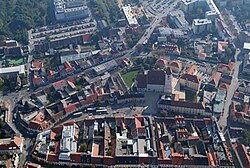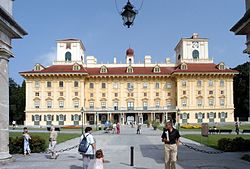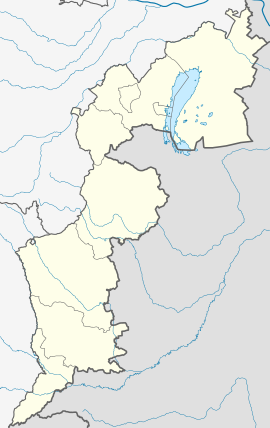
Back Eisenstadt Afrikaans Eisenstadt AN آيزنشتات Arabic آيزنشتات ARZ Eisenstadt AST آیزناشتات AZB Eisenstadt BAN Eisnstod BAR Айзенштат Byelorussian Айзэнштат BE-X-OLD
Eisenstadt | |
|---|---|
|
Clockwise from top: aerial view of the city, state government building, Schloss Esterházy, calvary with Bergkirche | |
| Coordinates: 47°51′N 16°31′E / 47.850°N 16.517°E | |
| Country | |
| State | Burgenland |
| District | Statutory city |
| Government | |
| • Mayor | Thomas Steiner (ÖVP) |
| Area | |
• Total | 42.88 km2 (16.56 sq mi) |
| Elevation | 182 m (597 ft) |
| Population (2018-01-01)[2] | |
• Total | 14,476 |
| • Density | 340/km2 (870/sq mi) |
| Time zone | UTC+1 (CET) |
| • Summer (DST) | UTC+2 (CEST) |
| Postal code | 7000 |
| Area code | 02682 |
| Vehicle registration | E |
| Budget | €42.256 million (2021)[3] |
| Expenditure | €42.255 million (2021)[4] |
| Website | www.eisenstadt.gv.at |
Eisenstadt (German pronunciation: [ˈaɪzn̩ʃtat] ⓘ; Austro-Bavarian: Eisnstod; Hungarian: Kismarton; Croatian: Željezni grad or Željezno; Slovene: Železno) is the capital city of the Austrian state of Burgenland. With a population of 15,074 (as of 2023), it is the smallest state capital and the 38th-largest city in Austria overall. It lies at the foot of the Leitha Mountains hill range.
From 1648 to 1921, Kismarton/Eisenstadt was part of the Habsburg Empire's Kingdom of Hungary and the seat of the Hungarian noble family Eszterházy. During this time, the composer Joseph Haydn lived and worked in Eisenstadt as a court musician under the patronage of the Esterházy family. After the cessation of Burgenland to Austria in 1921, the city became the province's capital in 1925. As the state capital of Burgenland, it functions as a center of public administration and services[5][6] and is the seat of three institutes of higher education.
- ^ "Dauersiedlungsraum der Gemeinden Politischen Bezirke und Bundesländer - Gebietsstand 1.1.2018". Statistics Austria. Retrieved 10 March 2019.
- ^ "Einwohnerzahl 1.1.2018 nach Gemeinden mit Status, Gebietsstand 1.1.2018". Statistics Austria. Retrieved 9 March 2019.
- ^ "Eisenstadt Ergebnishaushalt". www.offenerhaushalt.at (in German). 2021. Retrieved 2021-04-02.
- ^ "Eisenstadt Ergebnishaushalt". www.offenerhaushalt.at (in German). 2021. Retrieved 2021-04-02.
- ^ "Eisenstadt | Baroque Architecture, Burgenland & Music | Britannica".
- ^ "Burgenland | Austria's Easternmost State & its History | Britannica".







